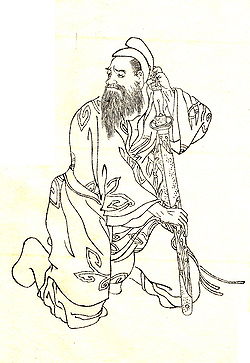
Mononobe no Arakabi
Encyclopedia

was a government minister during the Kofun period
Kofun period
The is an era in the history of Japan from around 250 to 538. It follows the Yayoi period. The word kofun is Japanese for the type of burial mounds dating from this era. The Kofun and the subsequent Asuka periods are sometimes referred to collectively as the Yamato period...
of ancient Japanese history.
In 512, the king of the Korean kingdom of Baekje
Baekje
Baekje or Paekche was a kingdom located in southwest Korea. It was one of the Three Kingdoms of Korea, together with Goguryeo and Silla....
(called Kudara by the Japanese) requested to take control of four districts of the land of the Gaya confederacy
Gaya confederacy
Gaya was a confederacy of territorial polities in the Nakdong River basin of southern Korea, growing out of the Byeonhan confederacy of the Samhan period.The traditional period used by historians for Gaya chronology is 42–532 CE...
(known to the Japanese as Mimana). Arakabi was ordered by Emperor Keitai
Emperor Keitai
, also known as Keitai-okimi, was the 26th emperor of Japan, according to the traditional order of succession.No firm dates can be assigned to this emperor's life or reign, but he is conventionally considered to have reigned from 507–531....
to report the emperor's consent, but at the advice of his wife feigned illness and claimed to be unable to make the journey. The legendary Japanese warrior queen Empress Jingū was said to have conquered these lands for the Yamato state some centuries earlier (around the years 200–300 CE), and Arakabi and his wife took this as a sign that the kami
Kami
is the Japanese word for the spirits, natural forces, or essence in the Shinto faith. Although the word is sometimes translated as "god" or "deity", some Shinto scholars argue that such a translation can cause a misunderstanding of the term...
wished for these lands to be in Japanese hands.
As minister, Arakabi led expeditions to fight off outside peoples, and also to repress the revolts of various rebellious elements within the Yamato state, such as Iwai, the governor of Tsukushi, whose revolt
Iwai Rebellion
The was a rebellion against the Yamato court that took place in Tsukushi, Japan in 527 AD. The rebellion was named after its leader, Iwai, who is believed by historians to have been a powerful governor of Tsukushi. The rebellion was quelled by the Yamato court, and played an important part in the...
was repressed in 527.
External links
- Nihon Shoki Online English Translations.Scroll 17 - Emperor Keitai

